Spatial Analysis of Intercity Migration Patterns of China’s Rural Population: Based on the Network Perspective
Abstract
1. Introduction
2. Literature Review and Research Hypotheses
3. Materials and Methods
3.1. Data Source
3.2. Research Methods
3.2.1. Spatial Autocorrelation Analysis
3.2.2. Hotspot Analysis
3.2.3. Network Analysis
- (1)
- Node Degree
- (2)
- Node Strength
- (3)
- Node Importance
- (4)
- Node Symmetry
- (5)
- Community Detection
4. Results
4.1. Analysis of Spatial Characteristics of Rural Population Migration
4.1.1. Spatial Autocorrelation of Rural Population Migration
4.1.2. Spatial Distribution of Hot and Cold Spots in Rural Population Migration
4.2. Network Characteristics Analysis of Rural Population Migration
4.2.1. The Flow Size and Direction of Rural Populations
4.2.2. Node Degree and Node Strength of Cities in Different Regions
4.2.3. Differences in Node Characteristics among Cities of Different Levels
4.3. City Cluster Detection of Rural Population Migration
4.3.1. Four-Tier Structure Mode: “North China”, “Jiangsu-Zhejiang-Anhui-Jiangxi”, and “Southwest China” Clusters
4.3.2. Three-Layer Structure Mode: “Northeast China and Inner Mongolia” and “Hubei-Fujian” Clusters
4.3.3. “Fault Type” Three-Tier Structural Mode: “Northwest China” Cluster
4.3.4. Double-Tier Structure Mode: “Guangdong-Hunan-Guangxi-Hainan” Cluster
5. Discussion
5.1. Summary of Research Results and Validation of Hypotheses
5.2. Analysis of the Causes of Rural Population Migration Network
5.3. The Enlightenment Gained from This Study
6. Conclusions
- (1)
- There is a significant spatial autocorrelation in both the inflow and outflow directions of rural populations. The migration patterns of rural populations among cities exhibit notable spatial clustering characteristics and spatial dependence effects. There are commonalities in the rural population flow between neighboring cities, showing a regional clustering tendency in geographical space. Moreover, distinct spatial patterns emerge in the inflow and outflow directions, reflecting a “west cold, east hot” trend and an “external cold, internal hot” pattern, respectively.
- (2)
- Cities of different administrative levels exhibit distinct node characteristics in the migration network. Municipalities directly under the central government, sub-provincial cities, and provincial capitals demonstrate a pronounced tendency to absorb rural populations, while ordinary prefecture-level cities and county-level cities primarily radiate rural populations outward. Regarding regional disparities, cities in the eastern region have larger sizes and scopes for absorbing rural populations. In the central region, cities predominantly act as sources for cross-regional migration. Rural populations in the western region mainly engage in intra-regional migration, and in the northeastern region, rural population migration is not active.
- (3)
- Cities across China have coalesced into seven major clusters within the rural population migration network. Intra-cluster cities exhibit closely knit relationships in terms of population movements, with municipalities directly under the central government and provincial capitals holding significant positions and roles as regional hubs in each cluster. The differing importance levels of cities contribute to distinct structural characteristics within each cluster. Factors such as economic dynamics, cultural influences, and industrial layouts collectively drive the emergence of these structural patterns.
- (4)
- The driving forces attracting the concentration of rural populations include robust infrastructure, educational facilities, healthcare services, and a well-developed secondary and tertiary sector. Aiming to achieve the goal of “revitalizing rural areas”, governments in areas experiencing population outflows might consider focusing on county-level city development. This involves actively undertaking and optimizing industrial layouts to attract rural migrants for local employment and urbanization, thereby catalyzing innovation in rural industries and promoting overall urban–rural integration.
Author Contributions
Funding
Institutional Review Board Statement
Data Availability Statement
Conflicts of Interest
References
- Gupta, D. An overview on internal migration in India: Trends and challenges. Int. J. Res. Anal. Rev. 2020, 7, 475–486. [Google Scholar]
- Rezayee, M.; Ling, G.H.T.; Misnan, S.H. Approaches to addressing informal settlement problems: A case study of district 13 in Kabul, Afghanistan. Eng. Manag. Res. 2020, 9, 1. [Google Scholar] [CrossRef]
- Population Division of United Nations. World Urbanization Prospects: The 2018 Revision. Available online: https://population.un.org/wup/Publications/ (accessed on 10 March 2024).
- Litwack, J.M.; Qian, Y. Balanced or unbalanced development: Special economic zones as catalysts for transition. J. Comp. Econ. 1998, 26, 117–141. [Google Scholar] [CrossRef]
- Wilonoyudho, S.; Rijanta, R.; Keban, Y.T.; Setiawan, B. Urbanization and regional imbalances in Indonesia. Indones. J. Geogr. 2017, 49, 125–132. [Google Scholar] [CrossRef]
- Bell, M.; Bernard, A.; Edwards, E.C.; Zhu, Y. Internal Migration in the Countries of Asia: A Cross-National Comparison; Springer: Cham, Switzerland, 2020. [Google Scholar] [CrossRef]
- Guilmoto, C.Z.; Jones, G.W. Contemporary Demographic Transformations in China, India and Indonesia; Springer: Cham, Switzerland, 2016. [Google Scholar] [CrossRef]
- Wang, S.; Yue, X.M. The grain-for-green project, non-farm employment, and the growth of farmer income. Econ. Res. J. 2017, 52, 106–119. [Google Scholar]
- Selod, H.; Shilpi, F. Rural-urban migration in developing countries: Lessons from the literature. Reg. Sci. Urban Econ. 2021, 91, 103713. [Google Scholar] [CrossRef]
- Luca, M.; Barlacchi, G.; Oliver, N.; Lepri, B. Leveraging mobile phone data for migration flows. arXiv 2021, arXiv:215.14956. [Google Scholar]
- Hankaew, S.; Phithakkitnukoon, S.; Demissie, M.G.; Kattan, L.; Smoreda, Z.; Ratti, C. Inferring and modeling migration flows using mobile phone network data. IEEE Access 2019, 7, 164746–164758. [Google Scholar] [CrossRef]
- Nasrudin, R.; Resosudarmo, B.P. Mental health assimilation of rural–urban migrants in developing countries: Evidence from Indonesia’s four cities. Pap. Reg. Sci. 2023, 102, 761–790. [Google Scholar] [CrossRef]
- Rai, P. The labor of social change: Seasonal labor migration and social change in rural western India. Geoforum 2018, 92, 171–180. [Google Scholar] [CrossRef]
- Simon, C.; Stark, O. Rural-to-urban migration, human capital, and agglomeration. J. Econ. Behav. Organ. 2008, 68, 234–247. [Google Scholar] [CrossRef]
- Oliveira, J.; Pereda, P. The impact of climate change on internal migration in Brazil. J. Environ. Econ. Manag. 2020, 103, 102340. [Google Scholar] [CrossRef]
- Nandy, A.; Tiwari, C.; Kundu, S. India’s Rural Employment Guarantee Scheme–How does it influence seasonal rural out-migration decisions? J. Policy Model. 2021, 43, 1181–1203. [Google Scholar] [CrossRef]
- Villalobos, C.; Riquelme, A. Household constraints and dysfunctional rural–urban migration. Econ. Anal. Policy 2023, 78, 1070–1088. [Google Scholar] [CrossRef]
- Akay, A.; Bargain, O.; Zimmermann, K.F. Relative concerns of rural-to-urban migrants in China. J. Econ. Behav. Organ. 2012, 81, 421–441. [Google Scholar] [CrossRef]
- Phan, D.; Coxhead, I. Inter-provincial migration and inequality during Vietnam’s transition. J. Dev. Econ. 2010, 91, 100–112. [Google Scholar] [CrossRef]
- Nguyen, L.D.; Raabe, K.; Grote, U. Rural–urban migration, household vulnerability, and welfare in Vietnam. World Dev. 2015, 71, 79–93. [Google Scholar] [CrossRef]
- Mohabir, N.; Jiang, Y.; Ma, R. Chinese floating migrants: Rural-urban migrant labourers’ intentions to stay or return. Habitat Int. 2017, 60, 101–110. [Google Scholar] [CrossRef]
- Michele, D.M.; Sciabolazza, L.V.; Molini, V. Migration in Libya: A spatial network analysis. World Dev. 2023, 163, 106139. [Google Scholar] [CrossRef]
- Shen, S.J.; Shen, G.C. Analysis on the spatial structure of inter-provincial migrant in China. Popul. J. 2020, 42, 103–112. [Google Scholar] [CrossRef]
- Wang, X.X.; Gao, X.D. The evolution of China’s floating population and its impact on urbanization: A comparative analysis based on inter and intra-provincial perspectives. Sci. Geogr. Sin. 2019, 39, 1866–1874. [Google Scholar] [CrossRef]
- Zou, X.Q.; Xie, M.H.; Xiao, Z.G.; Chen, H.Y. The coupling and spatial coordination characteristics between agricultural population migration and urban construction land increase in Jiangxi Province. China Land Sci. 2019, 33, 31–38. [Google Scholar] [CrossRef]
- Long, C.H.; Yi, C.Z. Pattern of China’ s rural labor mobility and training of the modern new farmers. Inq. Into Econ. Issues 2011, 1, 104–110. [Google Scholar] [CrossRef]
- Mei, J.M.; Liu, F.R. Spatial agglomeration pattern and mechanism of rural-urban migrants. J. South China Agric. Univ. (Soc. Sci. Ed.) 2023, 22, 46–58. [Google Scholar] [CrossRef]
- Xue, Y.F. An empirical research on the spatial distribution characteristics of rural labor migration in China. Econ. Surv. 2006, 2, 116–120. [Google Scholar] [CrossRef]
- Moran, P.A.P. The interpretation of statistical maps. J. R. Stat. Soc. 1948, 37, 243–251. [Google Scholar] [CrossRef]
- Moran, P.A.P. Notes on continuous stochastic phenomena. Biometrika 1950, 37, 17–33. [Google Scholar] [CrossRef] [PubMed]
- Getis, A.; Ord, J.K. The analysis of spatial association by use of distance statistics. Geogr. Anal. 1992, 24, 189–206. [Google Scholar] [CrossRef]
- Ord, J.K.; Getis, A. Local spatial autocorrelation statistics: Distributional issues and an application. Geogr. Anal. 1995, 27, 286–306. [Google Scholar] [CrossRef]
- Miranker, M.; Giordano, A. Map silences and chronic humanitarian crises: Spatial patterns of migrant mortality in South Texas, 2009–2020. Forensic Sci. Int. 2023, 353, 111861. [Google Scholar] [CrossRef]
- Krisjane, Z.; Berzins, M.; Krumins, J.; Apsite-Berina, E.; Balode, S. Uneven geographies: Ageing and population dynamics in Latvia. Reg. Sci. Policy Pract. 2023, 15, 893–909. [Google Scholar] [CrossRef]
- Erdös, P.; Rényi, A. On random networks. Publ. Math. 1959, 6, 290–297. [Google Scholar]
- Erdős, P.; Rényi, A. On the evolution of random graphs. Publ. Math. Inst. Hung. Acad. Sci. 1960, 5, 17–60. [Google Scholar]
- Watts, D.J.; Strogatz, S.H. Collective dynamics of small-world networks. Nature 1998, 393, 440–442. [Google Scholar] [CrossRef] [PubMed]
- Barabasi, A.L.; Albert, R. Emergence of scaling in random networks. Science 1999, 286, 509–512. [Google Scholar] [CrossRef] [PubMed]
- Barabasi, A.L.; Jeong, H.; Albert, R. Mean-field theory for scale-free random networks. Phys. A Stat. Mech. Its Appl. 1999, 272, 173–187. [Google Scholar] [CrossRef]
- Newman, E.J. The structure and function of complex networks. SIAM Rev. 2003, 45, 167–256. [Google Scholar] [CrossRef]
- Hafner-Burton, E.M.; Kahler, M.; Montgomery, A.H. Network analysis for international relations. Int. Organ. 2009, 63, 559–592. [Google Scholar] [CrossRef]
- Háznagy, A.; Fi, I.; London, A.; Nemeth, T. Complex network analysis of public transportation networks: A comprehensive study. In Proceedings of the 2015 International Conference on Models and Technologies for Intelligent Transportation Systems (MT-ITS), Budapest, Hungary, 3–5 June 2015; pp. 371–378. [Google Scholar] [CrossRef]
- Wissink, M.; Mazzucato, V. In transit: Changing social networks of sub-Saharan African migrants in Turkey and Greece. Soc. Netw. 2018, 53, 30–41. [Google Scholar] [CrossRef]
- Seminario, R. Timing and networks: Embedding patterns of Peruvian migrants in Switzerland. Soc. Netw. 2022, 71, 49–60. [Google Scholar] [CrossRef]
- Blondel, V.D.; Guillaume, J.L.; Lambiotte, R.; Lefebvre, E. Fast unfolding of community hierarchies in large networks. J. Stat. Mech. Theory 2008, 25, 155–168. [Google Scholar] [CrossRef]
- Liu, B.B.; Lin, B.; Feng, B.; Shi, Q.H. Labor mobility and rural social security: Models and evidence. J. Manag. World 2017, 9, 73–84. [Google Scholar] [CrossRef]
- Li, H.B.; Qiu, B.X. The influence of city level on the citizenization tendency of migrant workers. Urban Probl. 2019, 11, 20–29. [Google Scholar] [CrossRef]
- Ma, X.; Qiu, L.; Son, H. Industry selection of regional migrants in China: The role of urban industry structures of home and destination. World Econ. 2024, 47, 1427–1459. [Google Scholar] [CrossRef]
- Norocel, O.C.; Hellström, A.; Jørgensen, M.B. Nostalgia and Hope: Intersections between Politics of Culture, Welfare, and Migration in Europe; Springer Nature: Basel, Switzerland, 2020. [Google Scholar]
- Rudiarto, I.; Hidayani, R.; Fisher, M. The bilocal migrant: Economic drivers of mobility across the rural-urban interface in Central Java, Indonesia. J. Rural. Stud. 2020, 74, 96–110. [Google Scholar] [CrossRef]
- Pham, N.N.K.; Do, M.; Bui, V.H.; Nguyen, G.T. Rural-to-urban migration in Vietnam: Conceptualized youth’s vulnerabilities in the city. Int. J. Migr. Health Soc. Care 2018, 14, 117–130. [Google Scholar] [CrossRef]
- Reja, M.S.; Das, B. Labour migration within India: Motivations and social networks. South Asia Res. 2019, 39, 125–142. [Google Scholar] [CrossRef]
- Pardede, E.L.; McCann, P.; Venhorst, V.A. Internal migration in Indonesia: New insights from longitudinal data. Asian Popul. Stud. 2020, 16, 287–309. [Google Scholar] [CrossRef]
- Şener, F. Schumpeterian unemployment, trade and wages. J. Int. Econ. 2001, 54, 119–148. [Google Scholar] [CrossRef]
- Jofre-Monseny, J. The effects of unemployment protection on migration in lagging regions. J. Urban Econ. 2014, 83, 73–86. [Google Scholar] [CrossRef]
- Dos Santos, M.D.; Taugourdeau, E. Social network, unemployment and sector trap: A theoretical model explaining the case study of Portuguese immigrants in the French labor market. Math. Soc. Sci. 2021, 112, 61–71. [Google Scholar] [CrossRef]
- Huang, H.P. Cultural integration, network co-construction and resource sharing: Practical exploration of migrant youth from urban integration to urban-rural symbiosis. J. Nanjing Agric. Univ. (Soc. Sci. Ed.) 2021, 24, 94–102. [Google Scholar] [CrossRef]
- Massey, D.S.; Arango, J.; Hugo, G.; Kouaouci, A.; Pellegrino, A.; Taylor, J.E. Theories of international migration: A review and appraisal. Popul. Dev. Rev. 1993, 19, 431–466. [Google Scholar] [CrossRef]
- Blumenstock, J.E.; Chi, G.; Tan, X. Migration and the value of social networks. Rev. Econ. Stud. 2023, rdad113. [Google Scholar] [CrossRef]
- Bilecen, B.; Gamper, M.; Lubbers, M.J. The missing link: Social network analysis in migration and transnationalism. Soc. Netw. 2018, 53, 1–3. [Google Scholar] [CrossRef]
- Kotavaara, O.; Antikainen, H.; Rusanen, J. Population change and accessibility by road and rail networks: GIS and statistical approach to Finland 1970–2007. J. Transp. Geogr. 2011, 19, 926–935. [Google Scholar] [CrossRef]
- Balaz, V.; Williams, A.M. Risk attitudes and migration experience. J. Risk Res. 2011, 14, 583–596. [Google Scholar] [CrossRef]
- Jaeger, D.A.; Dohmen, T.; Falk, A.; Huffman, D.; Sunde, U.; Bonin, H. Direct evidence on risk attitudes and migration. Rev. Econ. Stat. 2010, 92, 684–689. [Google Scholar] [CrossRef]
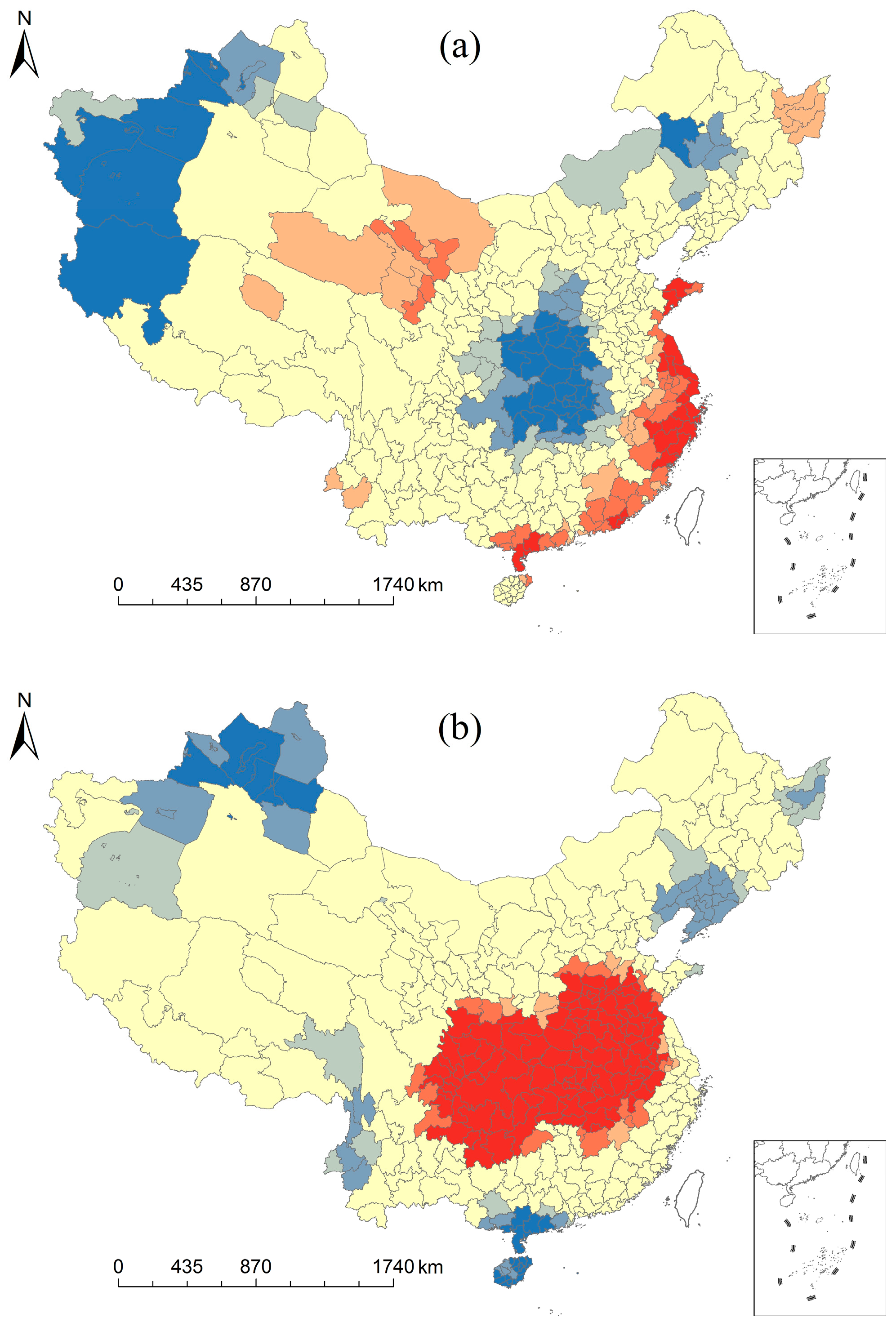
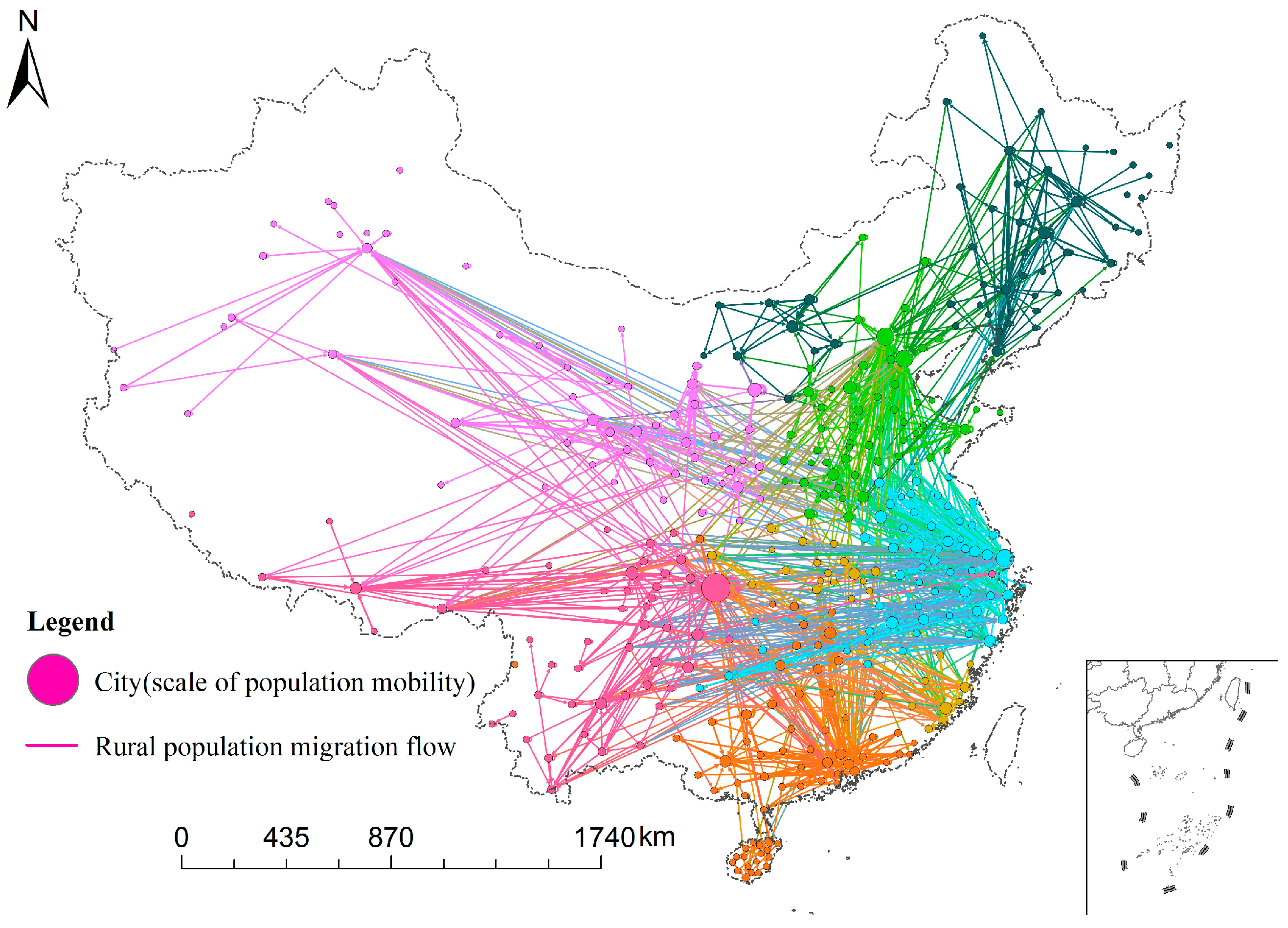
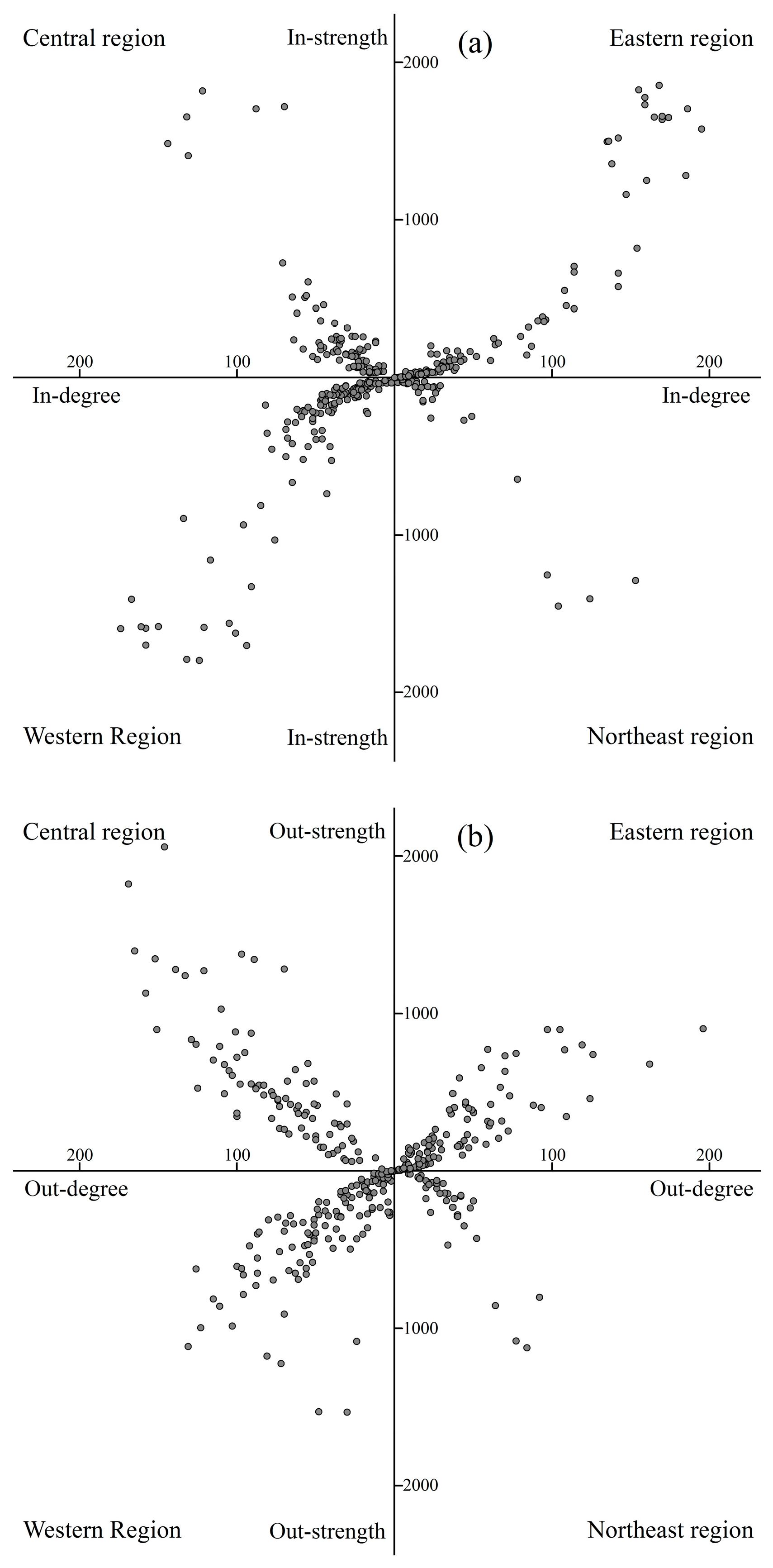
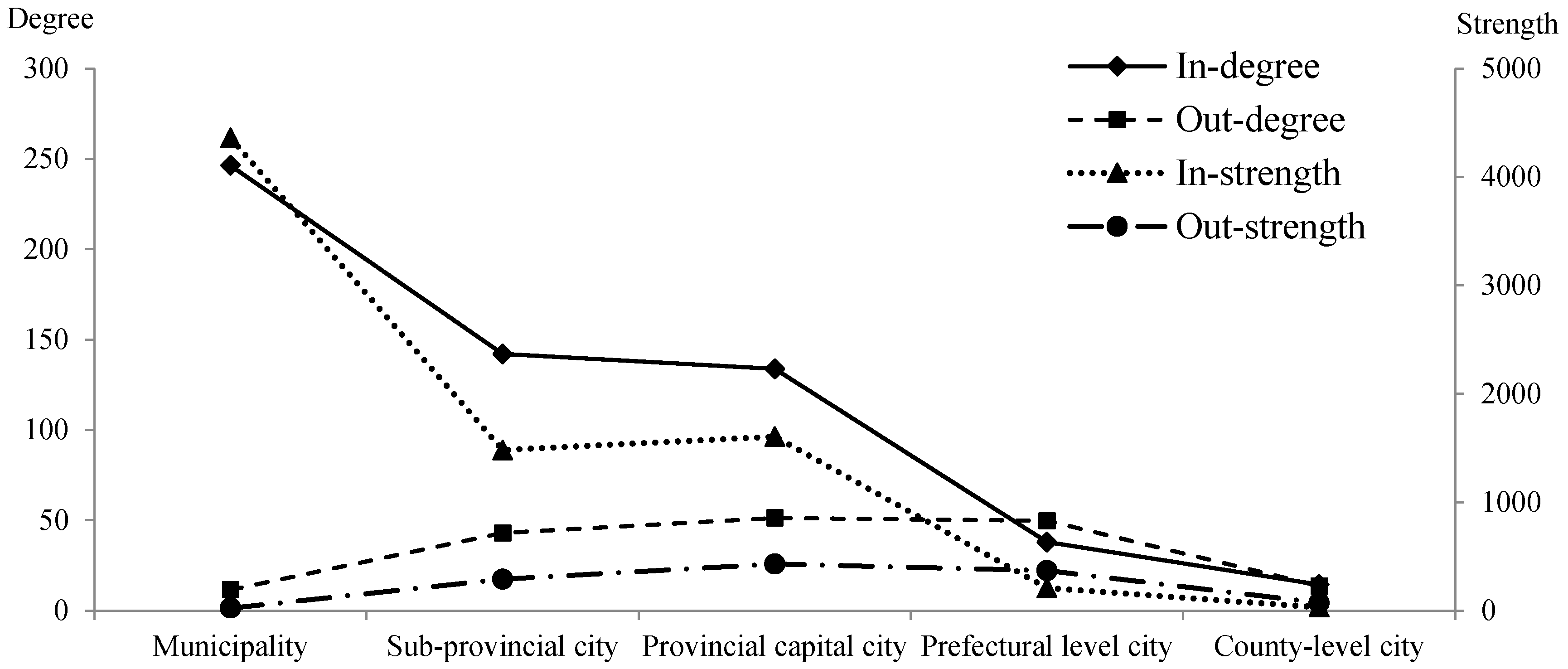
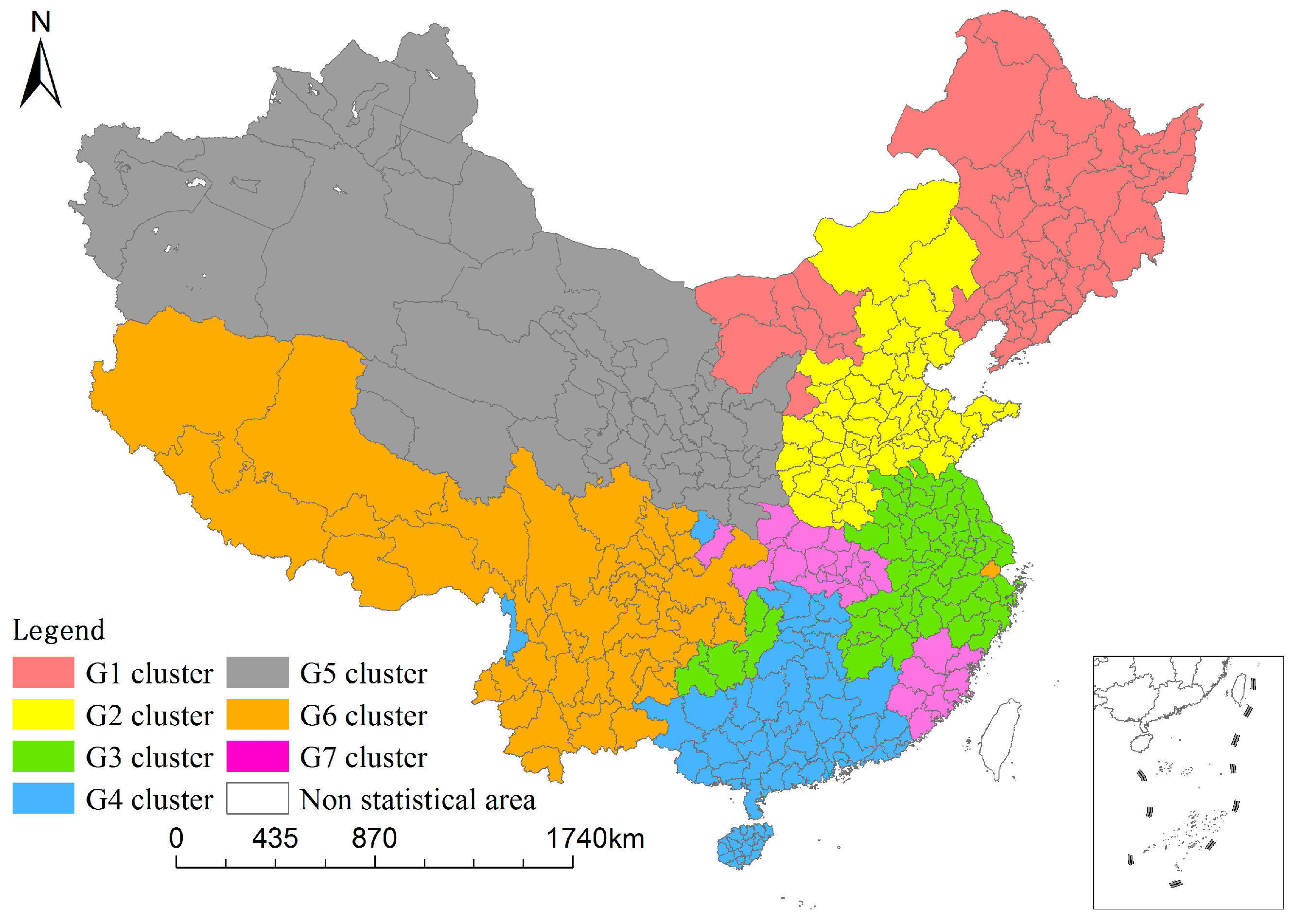
| Characteristic | Ratio | Characteristic | Ratio |
|---|---|---|---|
| Age (year) | Average = 37.90 | Marriage | 85.65% |
| 15–25 | 12.09% | Gender | |
| 26–35 | 33.48% | Male | 57.35% |
| 36–45 | 29.24% | Female | 42.65% |
| 46–55 | 20.09% | Migration time (year) | Average = 12.09 |
| 56–65 | 3.93% | <3 | 11.20% |
| >65 | 1.18% | 3–5 | 13.37% |
| Educational attainment | Average = 3.15 | 6–10 | 23.58% |
| Have not attended school = 1 | 3.45% | >10 | 51.85% |
| Elementary school education = 2 | 18.71% | Number of cities migrated to | Average = 2.16 |
| Middle school education = 3 | 49.19% | 1 | 48.23% |
| High school education = 4 | 19.18% | 2 | 27.08% |
| Junior college education = 5 | 6.63% | 3 | 11.94% |
| College education = 6 | 2.70% | >3 | 12.75% |
| Post-graduate education = 7 | 0.14% |
| Outflow | Eastern | Central | Western | Northeast | Total Inflow from Outside |
|---|---|---|---|---|---|
| Inflow | |||||
| Eastern | 15.51% | 14.50% | 8.04% | 1.23% | 23.77% |
| Central | 1.21% | 16.02% | 0.98% | 0.08% | 2.27% |
| Western | 2.10% | 5.08% | 28.54% | 0.27% | 7.46% |
| Northeast | 0.45% | 0.45% | 0.35% | 5.17% | 1.24% |
| Total outflow to outside | 3.76% | 20.04% | 9.37% | 1.58% | / |
| Cluster | G1 | G2 | G3 | G4 | G5 | G6 | G7 |
|---|---|---|---|---|---|---|---|
| Importance | |||||||
| >1.00 | / | Beijing | Shanghai | / | Yulin | Chongqing | / |
| / | Tianjin | Hefei | / | / | / | / | |
| >0.85 | Changchun | Shijiazhuang | Fuyang | / | / | Chengdu | Quanzhou |
| / | / | Wenzhou | / | / | / | / | |
| >0.70 | Hohhot | Zhengzhou | Nanchang | Changsha | Xining | Kunming | Wuhan |
| Harbin | Zhoukou | Ningbo | Nanning | Xian | Lhasa | / | |
| / | / | Hangzhou | / | Lanzhou | Zunyi | / | |
| / | / | / | / | / | Guiyang | / | |
| Average clustering coefficient | 0.311 | 0.291 | 0.301 | 0.300 | 0.307 | 0.327 | 0.307 |
| Number of cities | 50 | 55 | 57 | 68 | 56 | 50 | 27 |
Disclaimer/Publisher’s Note: The statements, opinions and data contained in all publications are solely those of the individual author(s) and contributor(s) and not of MDPI and/or the editor(s). MDPI and/or the editor(s) disclaim responsibility for any injury to people or property resulting from any ideas, methods, instructions or products referred to in the content. |
© 2024 by the authors. Licensee MDPI, Basel, Switzerland. This article is an open access article distributed under the terms and conditions of the Creative Commons Attribution (CC BY) license (https://creativecommons.org/licenses/by/4.0/).
Share and Cite
Zhou, Y.; Chen, H.; Fang, T. Spatial Analysis of Intercity Migration Patterns of China’s Rural Population: Based on the Network Perspective. Agriculture 2024, 14, 655. https://doi.org/10.3390/agriculture14050655
Zhou Y, Chen H, Fang T. Spatial Analysis of Intercity Migration Patterns of China’s Rural Population: Based on the Network Perspective. Agriculture. 2024; 14(5):655. https://doi.org/10.3390/agriculture14050655
Chicago/Turabian StyleZhou, Yihu, Huiguang Chen, and Tingting Fang. 2024. "Spatial Analysis of Intercity Migration Patterns of China’s Rural Population: Based on the Network Perspective" Agriculture 14, no. 5: 655. https://doi.org/10.3390/agriculture14050655
APA StyleZhou, Y., Chen, H., & Fang, T. (2024). Spatial Analysis of Intercity Migration Patterns of China’s Rural Population: Based on the Network Perspective. Agriculture, 14(5), 655. https://doi.org/10.3390/agriculture14050655







